Effective marketing is what separates the top real estate agents and agencies from the rest.
Today’s buyers don’t just rely on word-of-mouth and yard signs, they do extensive online research when looking for properties and agents. That’s why it’s important that you have an extensive and well thought out online and offline presence.
In this guide, we go over the top 35 real estate marketing strategies you can use to generate more clients.
Content & SEO
1. Build a professional, mobile-friendly real estate website with clear navigation and lead capture forms
Your website is the first thing most potential clients will see when they search for you online.
Make sure your website is easy to navigate and optimized for mobile devices. Include intuitive menus and a property search feature.
Add a call-to-action and your contact information on every page. Additionally, consider implementing a lead capture form and integrating it with your CRM software so that you can follow up with leads automatically.
2. Publish consistent blog content answering client questions, sharing tips, and covering market insights
Blogging helps to build trust and allows you to attract more organic search traffic. Focus your blog content on topics that address your potential clients’ pain points. Such as “X Tips for Buying Your First Home” or “How to Sell Fast in a Competitive Market.”
You can also share seasonal tips, market updates, and even neighborhood spotlights.
With blogging, it’s important to be consistent. Try to publish at least one high-quality blog post every week.
Over time, you’ll build a large content library which will continue bringing in repeat visits and new clients consistently.
3. Write for local websites to gain authority and backlinks
Reach out to local news sites and online magazines and offer to write articles for them. Pitch topics that would be interesting to potential clients (e.g., real estate market trends, home buying or improvement tips, etc.).
Make sure to have a professional byline and photo ready to be included with the article. And don’t forget to include a link to your site in every article you write.
Over time, this will help you build authority and position you as a go-to real estate voice in your area. It will also improve your search engine visibility by allowing you to build relevant backlinks from local sites.
4. Conduct keyword research and create SEO-optimized pages
A crucial part of optimizing your real estate website for search engines is understanding how potential customers search for real estate and agencies in your area.
You can use tools like Ahrefs and Semrush to uncover relevant keywords (e.g., “miami condos for sale” or “2-bedroom condo in miami beach”). And then optimize your site’s pages for those keywords.
Make sure to target one primary keyword with each page, and then include that keyword throughout the page’s content (in the title, headings, and within the main text of the page). Don’t overdo it, though—only include the keyword where it makes sense to do so naturally.
Connect your pages with internal links to make it easier for search engines and users to find content on your site.
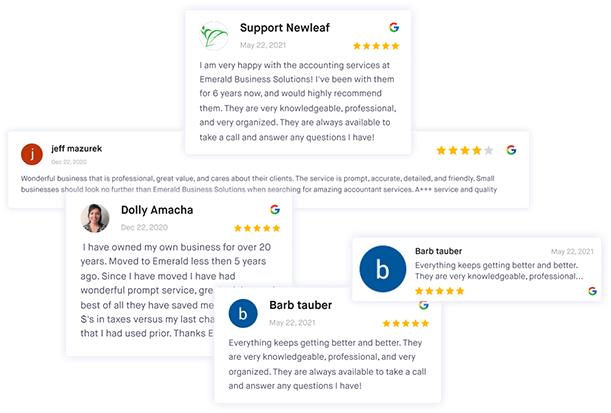
Manage all your reviews in one place
Get more reviews, build trust, and grow your business with ReviewsOnMyWebsite.
5. Build local landing pages for different neighborhoods, property types, or customer segments
Creating dedicated landing pages allows you to target specific audiences more effectively.
For example, if you have both commercial and residential real estate properties for sale, create separate landing pages for each. And include relevant listings and information.
You can do the same for different neighborhoods or areas. Make sure to optimize the pages by including relevant keywords throughout. This will give you a better chance of ranking individual pages in local search results.
6. Optimize your Google Business Profile and maintain consistent NAP information
Your Google Business Profile is what potential customers will see first if your business ranks in local search results. So it’s crucial that you optimize it by filling out all your business’s information and make sure it’s up-to-date at all times.
The most important part of your business’s information is your NAP (Name, Address, and Phone number). This needs to be accurate and consistent across all your business’s online listings.
Having consistent NAP information will show both search engines and potential customers that your business is legitimate.
Social media & video
7. Optimize your social media profiles
If you’re in the real estate business, your social media profiles are like your online business cards.
Fill out all the information on every profile (including adding a profile photo, a bio, and a link to your website).
Use a similar style and consistent visuals across all platforms to build brand recognition.
8. Post regularly using a content plan, batching, and templates
Post regularly to your social media channels to keep your audience engaged and your brand top of mind.
Try to schedule at least a month’s worth of content in advance so that you don’t have to rush your posts and risk creating subpar content. Tools like Buffer and Later can help with this.
Use different types of posts to keep things interesting. You can post your property listings, market updates, behind-the-scenes content, and more.
9. Use hashtags strategically
Using hashtags on platforms like X, Facebook, and Instagram can expand the reach of your posts and get them in front of people who don’t even follow you.
Research relevant hashtags in your area and use a mix of topical (e.g., “#openhouse”) and local (e.g., “#AustinRealEstate”) ones.
And combine low-volume and high-volume hashtags to balance reach with discoverability.
10. Share property walkthroughs, behind-the-scenes tours, and neighborhood spotlights
Creating and sharing property walkthroughs on social media can help potential buyers get a better feel for the properties you’re selling. Here, you’ll want to also showcase the surrounding area, including restaurants, schools, and parks.
You can also share behind-the-scenes tours of your business. This can help build trust and rapport with potential clients.
11. Live-stream open houses and Q&A sessions
Live streaming open houses and Q&A sessions can spark engagement and create a sense of urgency.
You can set up live streams on YouTube, Facebook, or Instagram and walk viewers through a property while also answering their questions at the same time.
Or host live Q&A sessions on topics like buying a first home or selling a property fast.
12. Share testimonials and client stories on social
Social media is a great place to share testimonials and reviews from your happy clients.
These can be in video or written form.
If you’re looking to create a video testimonial, try to show the client’s journey from the first viewing all the way through to closing.
Once you share the testimonial, tag the client so their friends and family can engage with the post and increase your reach.

Manage all your reviews in one place
Get more reviews, build trust, and grow your business with ReviewsOnMyWebsite.
Advertising & lead generation
13. Run PPC ad campaigns on Google, Bing, and other platforms
PPC advertising allows you to reach potential buyers quickly. You can use Google Ads and similar platforms to target people who are searching for properties in your area and promote your website and listings to them.
While it can drive results quickly, PPC advertising can also be very expensive. So you need to be careful and target the right keywords while keeping an eye on your ad spend.
14. Use retargeting ads for past website visitors and engaged audiences
Most of your website visitors won’t become clients straight away. So, it makes sense to retarget these people with ads to keep your brand and listings top of mind.
You can set up retargeting ads on platforms like Google, Facebook, and Instagram. These ads tend to provide a better return on ad spend compared to other types of ads since they target people who are already familiar with your brand.
15. A/B test ad copy, visuals, and CTAs
Don’t underestimate the power of tweaking your ads. Making small changes in ad copy, visuals, or your call-to-action can result in improved click-through rates and a reduced cost per lead.
Always test multiple versions of an ad to see which one performs better.
16. Link ads to dedicated, conversion-optimized landing pages
Are you sending all your ad traffic to your homepage? You might be missing out on conversions.
Create a dedicated landing page for each of your ad campaigns. This will allow you to tailor the landing page copy to your goal and create a smoother transition between the ad and your site experience.
Email & SMS marketing
17. Build and segment an email list
Building and maintaining an organized, segmented email list can make it a lot easier for you to sell properties. You can collect email addresses at a variety of touchpoints: at in-person networking events, from open house sign-in sheets, or your website’s lead capture form.
Once you’ve built up a list, creating different segments (e.g., buyers, sellers, past clients, etc.) can help you send personalized, targeted email campaigns with relevant content and offers.
This will allow you to get better open, click-through, and reply rates on your campaigns since every email will be highly relevant for the recipient.
18. Send regular newsletters with market updates, listings, and tips
A monthly or bi-weekly newsletter sent to your email subscribers can keep you top of mind and allow you to educate leads and clients.
You can include a mix of different types of content in your newsletter, including recently closed sales, new listings, market trends, and tips for buyers and sellers.
End every newsletter with a clear call-to-action (e.g., “Schedule a viewing” or “Get a home valuation).
19. Personalize emails and property recommendations
Take advantage of merge tags and dynamic content to personalize your emails with the recipient’s name, neighborhood, or preferences.
For the active buyers on your list, share listings that align with their search criteria. For sellers, include data on recent sales in the area or home values.
The more you personalize your email content, the more likely it is that recipients will engage with it or reach out to you.
20. Run SMS campaigns tied to property signs or events
SMS marketing is a quick and direct way to reach prospects.
Try adding a “Text for more information” SMS code to direct mailers, property signs, or event invitations. And then text listing details to those who subscribe to your SMS campaigns.
Aim to keep your texts fairly short and include a call-to-action.
Branding & engagement
21. Develop a strong personal brand with a clear value proposition
Identify your unique selling proposition (USP)—what makes you different from the competition.
This could be specialization in a specific type of property (e.g., luxury or commercial), a unique client experience, a very high closing rate, or something else.
Then, make sure to have your USP at the center of your marketing efforts. Use it across all your marketing materials, including your website, social media channels, ads, and printed materials.
22. Wear branded apparel and carry branded items
Branded apparel and items can help expose your brand to more people without seeming overly pushy.
Invest in branded shirts, caps, tote bags, or pens. Wear and carry these yourself and gift them to prospects and clients.
23. Offer personalized closing gifts or experiences
Closing gifts can make the experience of working with you much more memorable for clients. And increase the chances of them recommending you to their family and friends.
But instead of giving them a generic gift basket, consider something more personal. For example, you could give them a welcome mat customized with their family name. Or a subscription box for something that fits their lifestyle.
24. Build referral relationships with local businesses, service providers, and past clients
A strong partner network can increase referrals to your business and result in a steady stream of clients. Consider partnering with related businesses, such as mortgage brokers, landscapers, or moving companies.
Cross-promote each other’s services and exchange referrals.
Lawrence Irby, the president of Bay Area House Buyer, saw great results after partnering with a local moving company:
"We tried something new that worked out pretty well. We teamed up with a local moving company to host some events for people thinking about selling their homes.
We split the costs to keep it cheap and offered free property assessments right there to get sign-ups. That simple idea brought us 14 good leads in three months.
I think it worked because the help was actually useful for people in the neighborhood, so they were happy to call us later."
25. Automate review collection and display testimonials across channels
Your online reputation plays a big part in whether potential clients decide to work with you or not. Nowadays, people read 4-10 reviews when researching a business.
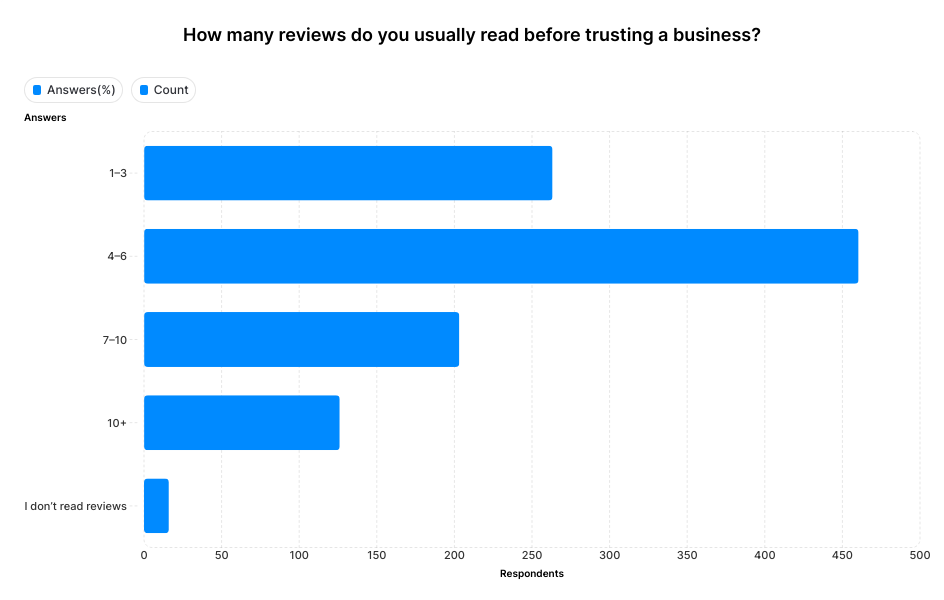
And they’re usually looking for recent reviews. So if you only have a handful of reviews from years ago, that won’t help you.
You need to have a system for collecting reviews consistently. One way to do it is to automate review collection by using automated email and SMS reminders.

Manage all your reviews in one place
Get more reviews, build trust, and grow your business with ReviewsOnMyWebsite.
ReviewsOnMyWebsite allows you to create automated email and SMS review request sequences in seconds.
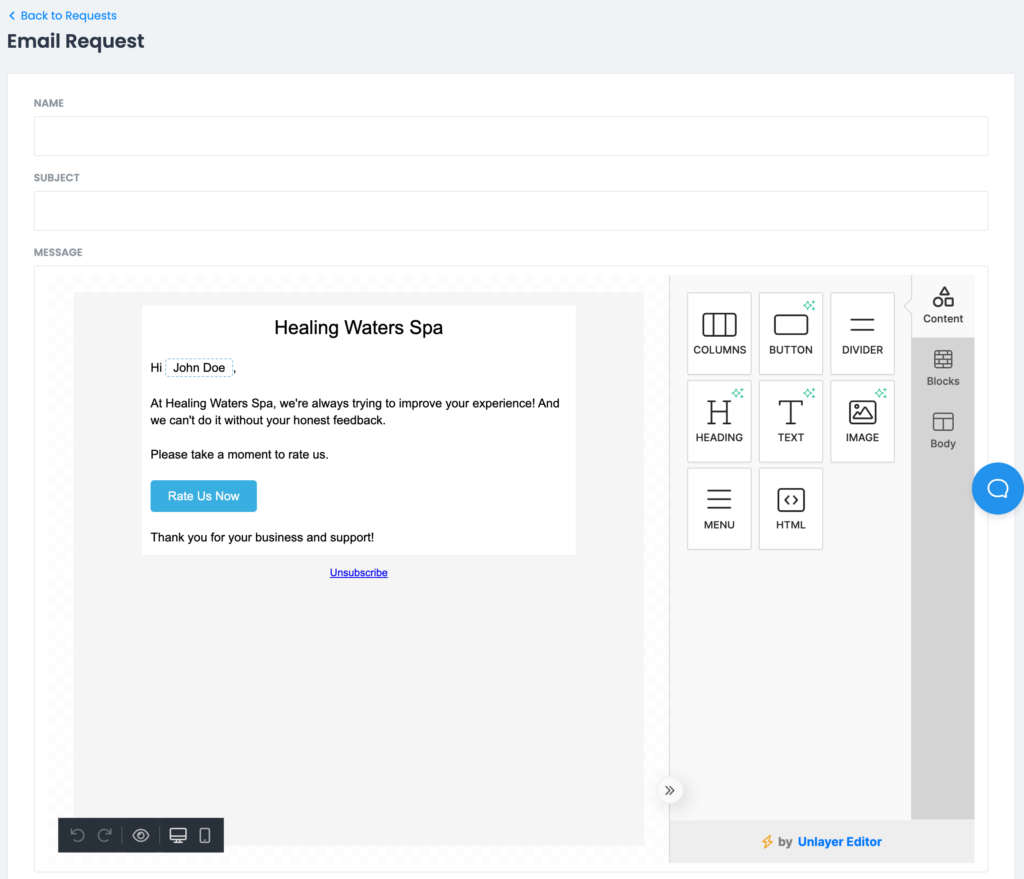
You can even set up follow-ups to periodically remind clients about leaving a review.
This will help you generate a steady stream of reviews every month.
But don’t stop there. Once you have a solid number of positive reviews, make sure everyone knows about them.
You can use ReviewsOnMyWebsite’s review widget to display top customer reviews on your website with ease. All you need to do is add a piece of code to your site.
The widget is completely customizable and can be adjusted to fit your brand’s look.
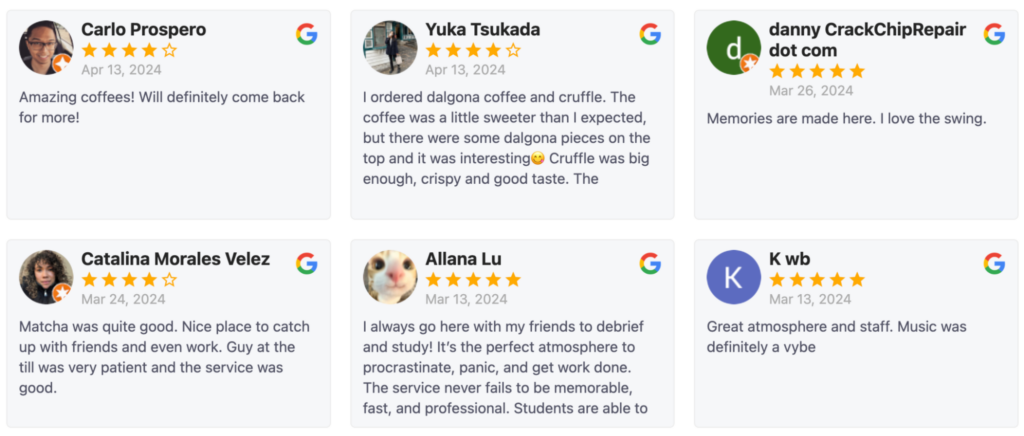
You can also share your reviews on social media. ReviewsOnMyWebsite’s social sharing feature makes it easy to turn your reviews into engaging social media images in a few clicks.
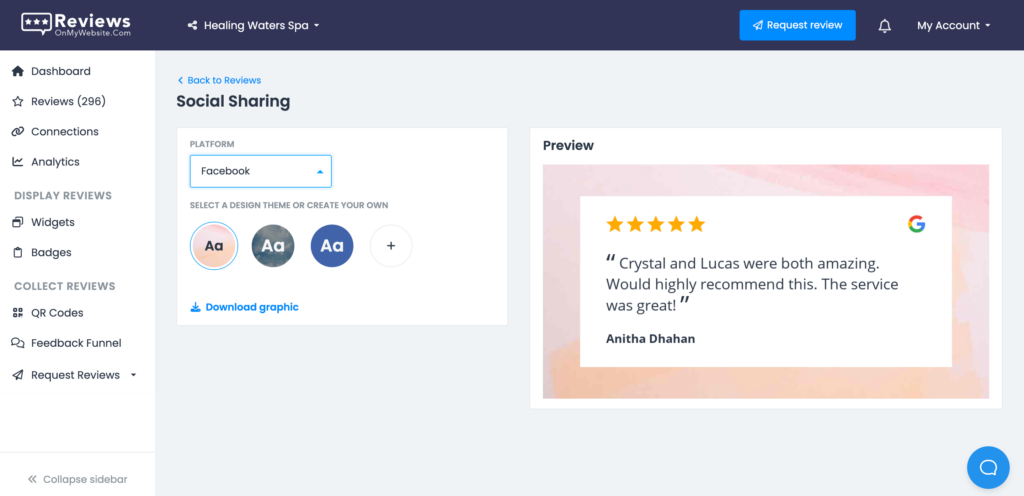
Listing marketing
26. Hire a professional photographer (and consider drone photography)
Investing in high-quality photography for your listings is one of the highest return on investment (ROI) moves you can make.
Hire a professional photographer who knows how to use lighting, composition, and angles to give properties an enticing and high-value look.
If you’re promoting large lots or properties with scenic views or unique architecture, consider drone photography. Using a drone can help you create dramatic aerial shots that capture the full scope and setting of a property.
27. Use 3D tours and VR experiences
3D tours and virtual reality (VR) experiences provide potential buyers with an interactive and immersive walkthrough of a property. And allow them to check out a property from anywhere in the world.
These types of tours are especially powerful for out-of-town buyers and those that can’t come to an in-person showing straight away.
28. Write emotional, benefit-driven property descriptions
Avoid using generic property descriptions that simply list square footage and bedroom count. Use emotional and lifestyle-focused language that helps potential buyers imagine living at a property.
Make sure to highlight what makes the property stand out (e.g., historic charm or a spacious backyard)
These types of descriptions can help build an emotional connection and make potential buyers eager to check out the property in person.
29. Feature top listings on your homepage and newsletters
When it comes to your most unique or desirable properties, you should make sure to feature them prominently on your site’s homepage to put them in the center of attention.
You can also promote them through social media posts and then pin those posts to your profile. And include the properties in your email newsletters.
Local & offline Marketing
30. Sponsor local events, teams, or festivals
Sponsoring local events, teams, and festivals can help get your name in front of potential clients in your area. It also allows you to build goodwill and develop relationships with event and festival organizers, as well as team owners.
By investing into sponsorships, you can have your branding placed on banners, programs, and event materials, potentially exposing your brand to thousands of people.
With many events featuring sponsors on their website or social media channels, the potential for exposure is even greater.
31. Host educational events
Organize and host educational events for first-time homebuyers and real estate investors. This will help to expose you to a whole new set of potential clients. And position you as an expert.
You can host these types of events in a community center, a library, or even virtually through social media platforms.
Make sure to collect attendees’ email addresses so that you can follow up with them later.
Mike Wall, the CEO of We Buy Gulf Coast Houses, uses events to get multiple new leads every month:
"Hosting monthly get-togethers for local landlords was one of my best moves this year.
It was a hassle booking a venue and inviting 15 people each time, but talking about my own renovation mistakes helped everyone relax.
I spent about $200 on the room and coffee, but always walked away with 3-4 new leads who became clients or great referral sources.
The open Q&A sealed the deal. People saw I was dealing with the same market problems and renovation headaches they were."
32. Send handwritten cards or seasonal gifts
In a world where everything seems to happen online, sending a handwritten note or card can stand out to prospects and clients as particularly thoughtful and personal.
You can use these to congratulate clients on their home purchase or send holiday greetings.
Apart from cards, you can also send clients small seasonal gifts, such as local delicacies. This will help nurture client relationships further and increase the chances of repeat business.
Keith Sant, the founder of Kind House Buyers, uses personailzed mailers to get more leads:
"My best performing campaign this year was the "Just Sold" Hyper-Targeted Mailer.
I chose a neighbourhood where one house had just set a record for the highest price and wrote 75 handwritten postcards in which I explained that, although that was an amazing price, I believed my buyers would be willing to eclipse it.
It wasn't a long, boastful full page of print about how much I was selling for in that one month, instead it offered a "Local Market Validation" report outlining exactly how the one high sold had increased the equity on their specific houses.
This campaign was around $100 for the materials and two hours of hand-addressing. It produced four immediate "home value" inquiries that transformed into two listing agreements and one buyer referral.
The strategy worked due to instant relevance. By concentrating on a "neighbour's success" over my own brand, I gave immediate value.
After that nearby sale, people had a natural curiosity about the value of their home and, when I provided the information without going for a hard close received my endorsement as the local market expert."
33. Attend and engage in community meetings and groups
Becoming an active participant in your local community by attending neighborhood association meetings, school board sessions, and other relevant meetings can help increase your visibility.
And allow you to build relationships with other members of your community. This, in turn, can lead to new business opportunities and referrals.
Advanced & creative Ideas
34. Build interactive tools like home valuation calculators
Creating interactive tools can encourage visitors to engage with your website and allow you to collect lead information.
For example, you could build a home valuation calculator that asks visitors for an email address before displaying an estimate. And once you get their email address, you can nurture leads further via email campaigns.
35. Create hyper-local market quizzes or polls
Engage potential buyers in your area by creating quizzes and polls on neighborhood trivia, homebuyer preferences, or market predictions.
You can then embed these on your website, share them on social media, or include them in your newsletters.
As with interactive tools, you can also use these to collect leads’ contact information so that you can nurture them into becoming clients over time.
Get more clients with an effective real estate marketing strategy
You’ve reached the end of this guide. Now it’s time to take action.
Pick 2-3 strategies from the list above and implement them this month. Track and measure your results and then adjust from there.




